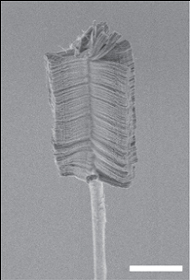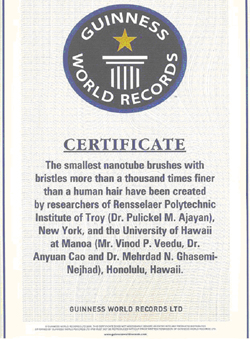Home > Press > US nanotechnologists make it to the Guinness Book of World Records
US nanotechnologists make it to the Guinness Book of World Records
Posted on April 04, 2006
The smallest nanotube brushes with bristles more than thousand times finer than a human hair have been created by researchers of Rensselaer Polytechnic Institute of Troy (Dr. Pulickel M. Ajayan), NY, and the University of Hawaii at Manoa (Mr. Vinod P. Veedu, Dr. Anyuan Cao and Dr. Mehrdad N. Ghasemi-Nejhad), Honolulu, Hawaii.

Nanotube Brush
|
These brushes can be used for sweeping up nano-dust, as electronic micro-switches, painting micro capillaries and even cleaning up pollutants in water. The bristles' secret is carbon nanotubes, tiny straw-like molecules just 30 billionths of a meter (30 nm) across. They are incredibly tough and yet flexible enough that they will yield when pushed from the side. The scientists grow bristles from hot, carbon-laden gas on to threads of silicon carbide finer than baby's hair. The researchers show how the brushes can sweep up piles of nano-dust. They have also shown that the brushes can be used to paint microstructures - dipped into a solution of iron oxide (rust), the minute brush hairs will pick up the red oxide particles which can then be wiped on to a bare surface. With the bristles coated in absorbent materials, the brushes will soak up toxic silver ions from contaminated water. Because of their strength, resistance to abrasion, and pliability, the nanobrushes may prove superior to macroscopic metal brushes in high-power motors. Conventional brush bristles, made of animal hairs, synthetic polymer fibers, and metal wires, are flimsy and prone to breaking down at the nano-scale. To work at the nano-scale, researchers realized that a different kind of material was needed. The small size, strength, elasticity, and ability to conduct electricity make carbon nanotubes as ideal bristle material at the nano-scale.
This work was a collaborative research conducted by the University of Hawaii (UH) at Manoa in Honolulu, Hawaii and Rensselaer Polytechnic Institute (RPI) in Troy, New York. The UH research team was lead by Prof. Mehrdad Ghasemi-Nejhad who also directs the Hawaii Nanotechnology Laboratory (HNL). Dr. Anyuan Cao is the associate director of HNL. Vinod Veedu is a PhD student at the UH department of mechanical engineering and conducts research at HNL. The RPI team was lead by Dr. Pulickel Ajayan, the Henry Burlage Professor of Materials Science and Engineering. Dr. Ajayan is a world-renowned expert in nanotechnology. Their work was reported in the journal Nature Materials in July 2005.
If you have a comment, please Contact us.
Issuers of news releases, not 7th Wave, Inc. or Nanotechnology Now, are solely responsible for the accuracy of the content.
| Related News Press |
Possible Futures
![]() Spinel-type sulfide semiconductors to operate the next-generation LEDs and solar cells For solar-cell absorbers and green-LED source October 3rd, 2025
Spinel-type sulfide semiconductors to operate the next-generation LEDs and solar cells For solar-cell absorbers and green-LED source October 3rd, 2025
Nanotubes/Buckyballs/Fullerenes/Nanorods/Nanostrings
![]() Enhancing power factor of p- and n-type single-walled carbon nanotubes April 25th, 2025
Enhancing power factor of p- and n-type single-walled carbon nanotubes April 25th, 2025
![]() Chainmail-like material could be the future of armor: First 2D mechanically interlocked polymer exhibits exceptional flexibility and strength January 17th, 2025
Chainmail-like material could be the future of armor: First 2D mechanically interlocked polymer exhibits exceptional flexibility and strength January 17th, 2025
![]() Innovative biomimetic superhydrophobic coating combines repair and buffering properties for superior anti-erosion December 13th, 2024
Innovative biomimetic superhydrophobic coating combines repair and buffering properties for superior anti-erosion December 13th, 2024
Announcements
![]() Rice membrane extracts lithium from brines with greater speed, less waste October 3rd, 2025
Rice membrane extracts lithium from brines with greater speed, less waste October 3rd, 2025
![]() Researchers develop molecular qubits that communicate at telecom frequencies October 3rd, 2025
Researchers develop molecular qubits that communicate at telecom frequencies October 3rd, 2025
![]() Next-generation quantum communication October 3rd, 2025
Next-generation quantum communication October 3rd, 2025
![]() "Nanoreactor" cage uses visible light for catalytic and ultra-selective cross-cycloadditions October 3rd, 2025
"Nanoreactor" cage uses visible light for catalytic and ultra-selective cross-cycloadditions October 3rd, 2025
|
|
||
|
|
||
| The latest news from around the world, FREE | ||
|
|
||
|
|
||
| Premium Products | ||
|
|
||
|
Only the news you want to read!
Learn More |
||
|
|
||
|
Full-service, expert consulting
Learn More |
||
|
|
||









